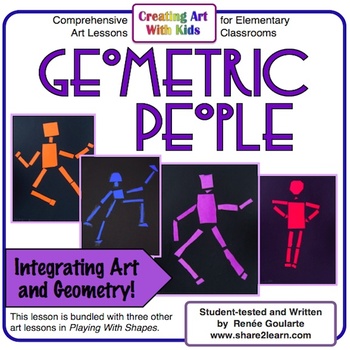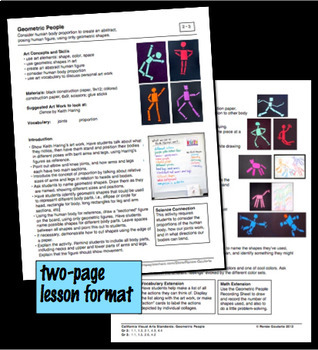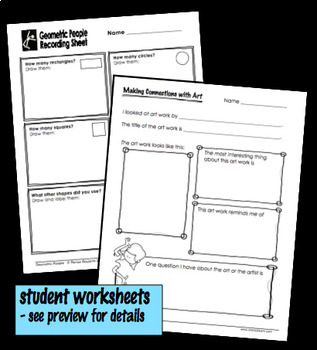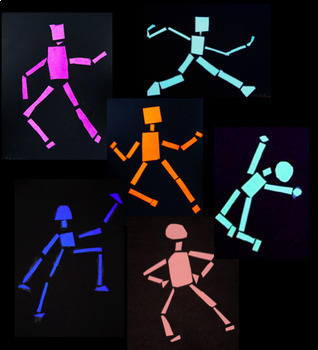Art Lesson Geometric People Integrating Art and Geometry
- PDF
Description
Integrate Art and Geometry with this failure-proof collage lesson that introduces students to average and standard proportions of the human body. Students work with geometric shapes to create a one-color collage that represents a human figure in motion after observing and discussing art work by American artist Keith Haring.
This lesson is easy to differentiate for a wide variety of students abilities and needs, so all students can be successful with this lesson. Those who are more adept with scissors may choose to include more details, while those students still developing small motor skills can focus primarily on main body parts and the position of arms and legs.
The lesson can be extended in several ways as noted in the resource, which also includes a math extension worksheet for younger students and an art reflection worksheet for older students. See preview for details.
Geometric People is bundled with three other lessons in Playing With Shapes
This lesson includes the following:
- a list of art concepts and skills addressed
- national visual arts standards information
- a list of materials needed
- targeted art and related vocabulary
- detailed steps for introducing the lesson
- directions for the art-making activity
- ideas for extending or varying the lesson
- ideas for looking at and discussing art
- ideas for connecting the activity to math and science
- a language arts/vocabulary extension
Worksheets included:
Geometric People Recording Sheet - counting and skip-counting
Making Connections with Art - writing about Keith Haring’s art work
This comprehensive art lesson is designed to teach art appreciation, artist behavior, and art analysis.
National Core Visual Arts Standards addressed are listed at the beginning of the lesson.
Listed grade levels are suggestions only; any of these lessons can be simplified or made more complex to work for any elementary grade.
Related art lessons:
For more art-making ideas and suggestions:
Start With Art -- perfect for back-to-school
Integrating Art Across the Curriculum Sampler Bundle - a collection of five integrated Art lessons
Making Time For Art -- a free download
Art Task Cards -- for early finishers or art centers
•••••
I am a retired elementary classroom teacher, a former art teacher, an artist and a writer. I have a Multiple Subjects credential, a Single Subject credential for Art and English, LDS/ESL certification, a Master’s Degree in Elementary Education with a Mathematics focus, and Montessori certification. I have worked with all elementary grades, and with special groups including ELL, GATE, and At-Risk students. Creating Art With Kids and Share2Learn lessons and resources are designed to foster student creativity, choice, and independence, and to encourage authentic art-making. Consideration is given to developmental appropriateness, differentiation possibilities, and teacher individuality. For this reason, directions are general, expectations are open-ended, and clip art on student pages is kept to a minimum.
•••••
Terms of Use:
Permission is granted to copy for single classroom use only, including homeschool classrooms, for use with classroom students. Additional licenses may be purchased for a reduced price. Electronic distribution is limited to single classroom use. Public and/or online display are not authorized; this resource may not be posted on district or classroom websites, or on any teaching resource websites, without permission of the author. Please do not give away my work.
•••••
Connect With Me:
Creating Art With Kids Facebook Group
•••••
Find out about new products, discounts, and freebies!
Look for the “follow me” link near the store logo at the top of the page. Become a follower to receive updates about my resources.
Get TpT credits!
Provide feedback on purchased products for TpT credits toward future purchases. Look in your “My Purchases” page for the “Provide Feedback” button.
Enjoy!





